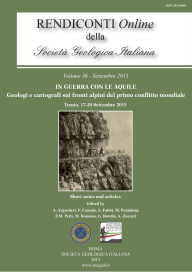
Sui ghiacciai: dalla gelida e bianca guerra alla loro tropicalizzazione
Christian Casarotto (a), Elena Bertoni (a) & Alberto Trenti (b)
(a) Muse, Museum of Science, Corso del Lavoro e della Scienza, 3, 38122, Trento, Italy. E-mail: christian.casarotto@muse.it; elena.bertoni@muse.it
(b) Autonomous Province of Trento, Forecasting and planning Office, via Vannetti, 41, 38122, Trento, Italy. E-mail: alberto.trenti@provincia.tn.it
DOI: https://doi.org/10.3301/ROL.2015.139
Volume: 36/2015
Pages: 39-42
Abstract
In occasion of the preparation of a new inventory for Trentino glaciers (2013), all historically available data (1958 CGI, 1987 SAT, 2003 PAT) were digitized in a geographic information system (GIS) with the aim to reconstruct the evolution of the glaciers from the end of the Little Ice Age (LIA) up to date. Through limits of moraines and glacial sediments, as well as those of active rock glaciers, the polygons of the glaciers at the maximum of the LIA (around 1850) were defined in GIS. At that time glaciers filled an area of about 110 km2. In the early 1900s, however, some glaciers disappeared, for example on Monzoni during the World War I.
The inventory 2013 (PAT) counts 120 glaciers with total area of about 32 km2. The average annual losses of glacial surface (ΔSy, in %) were compared for each of the considered four time periods. We have noticed that these losses have grown exponentially.
With the three-dimensional analysis of the 2003 and 2013 inventories, the average annual reduction in thickness was determined for the glaciers representative of the main mountain groups, for example on Adamello Glacier, and it has been observed to achieve values up to 4 000 mm water equivalent.
These data, which have a strong seasonal connotation, are comparable to those of monsoon systems, almost as if they would like to witness the tropicalization of climate resulting in global warming.
Keywords
Get Full Text